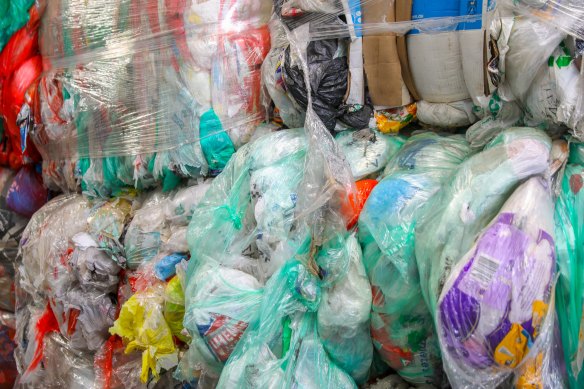In November, we discovered that much of the soft plastic we dropped off at supermarkets for recycling — shopping bags, wrappers, food packaging and the like — was not being recycled at all. Instead of being made into road bollards, outdoor furniture and rubbery footpaths, as we had believed, it was simply shoved into vast warehouses and forgotten about.
Plastic bags stockpiled in Sydney warehouses. Nearly 12,400 tonnes of soft plastics have now been located in 32 locations across the three states.
Environmental investigators have since discovered at least 12,000 tonnes of the stuff in stockpiles across three states, enough to fill 1000 semi-trailer trucks. Much, perhaps all, will end up in landfill. The NSW environmental regulator has already ordered that more than 5200 tonnes be cleared out of storage, where it is deemed a fire risk.
The collapse of the scheme, which so many Australians had diligently supported, is clearly a major setback in our efforts to do something about the enormous quantities of plastic waste we generate every year.
Not only does it mean thousands of tonnes of the stuff will no longer be recycled, this failure has damaged our trust in the entire system of waste management. Why should we bother collecting, sorting, and putting everything in the correct bin if it all just goes to landfill anyway?
REDcycle, the Melbourne company responsible for gathering the waste in the first place, has much to answer for, particularly its decision to keep collecting and storing plastics even after its third-party recyclers said they could no longer process them.
This is a wake-up call. At the very least, this episode has demonstrated in the most graphic terms just how much soft plastic we use, and have to dispose of, month after month: enormous piles that you quickly start measuring in terms of Olympic swimming pools. Once, we sent it to China: out of sight, out of mind (China banned imports of recyclables in 2018). Now it threatens to overwhelm us.
Of the 2.5 million tonnes of all plastic waste we generated in 2018-2019, only 9 per cent was sent for recycling, according to the Australian Bureau of Statistics, and much of that, as we know, would have ended up in landfill anyway. Households were the largest contributor, generating 1.2 million tonnes of plastic waste — nearly 50 kilograms for every Australian, or enough to fill 100,000 semi-trailers.
We have, or will have, the technology to deal with at least some of it: the $6 billion waste management group Cleanaway says it will make a decision later this year on a plan to collect 100,000 tonnes of soft plastics a year. Melbourne-based packaging company Amcor also recently announced plans for a new recycling plant.
The hurdle is economic viability. Who should pay for it, given that much recycling, post-China, is no longer profitable? One solution widely gaining acceptance overseas is to put the onus back on the manufacturers, a carrot-and-stick approach to both reduce the overall amount of plastic packaging and increase the quantity that can be made into new products.
In Germany, anyone who puts commercial packaging into circulation is obliged to retrieve and dispose of it properly. Packaging that is easily recycled or is made from recycled material or renewable raw materials reduces the licence fees.
In the US, New York is currently considering its own ″extended producer responsibility” bill, which would force producers to pay for curbside collection and should, say its proponents, prompt them to design packaging that is more sustainable. In Maine, manufacturers will be required to pay a levy based on the amount and the recyclability of their packaging products. San Francisco already requires residents to separate out their recyclables and compostables, by law, on its way to a goal of zero waste into landfill.
Recycling is not a magic bullet solution: it uses energy and chemicals, creates carbon emissions and can’t account for all plastics. Much of today’s packaging is made from a complex blend of several materials, which must be painstakingly separated.
Creating a “closed loop”, where as much plastic as possible is re-used, will be a global endeavour, Steve Alexander, chair of the international Association of Plastic Recyclers, told the Financial Times. “It requires a massive overhaul and collaboration between manufacturers, supermarkets, industry giants, governments, consumers — the likes of which we are not even close to witnessing.”
While we wait, those of us betrayed by the failure of the REDcycle scheme can still do our bit. Complain to supermarkets and manufacturers. Re-use where we can. And avoid products needlessly packed in plastic in the first place. A loose iceberg lettuce (now back to a reasonable price) instead of salad mix; potatoes in a paper bag, BYO sealable containers, cardboard boxes; it all helps to stem the flood — and to send a message.
Patrick Elligett sends an exclusive newsletter to subscribers each week. Sign up to receive his Note from the Editor.
Most Viewed in Environment
From our partners
Source: Read Full Article
